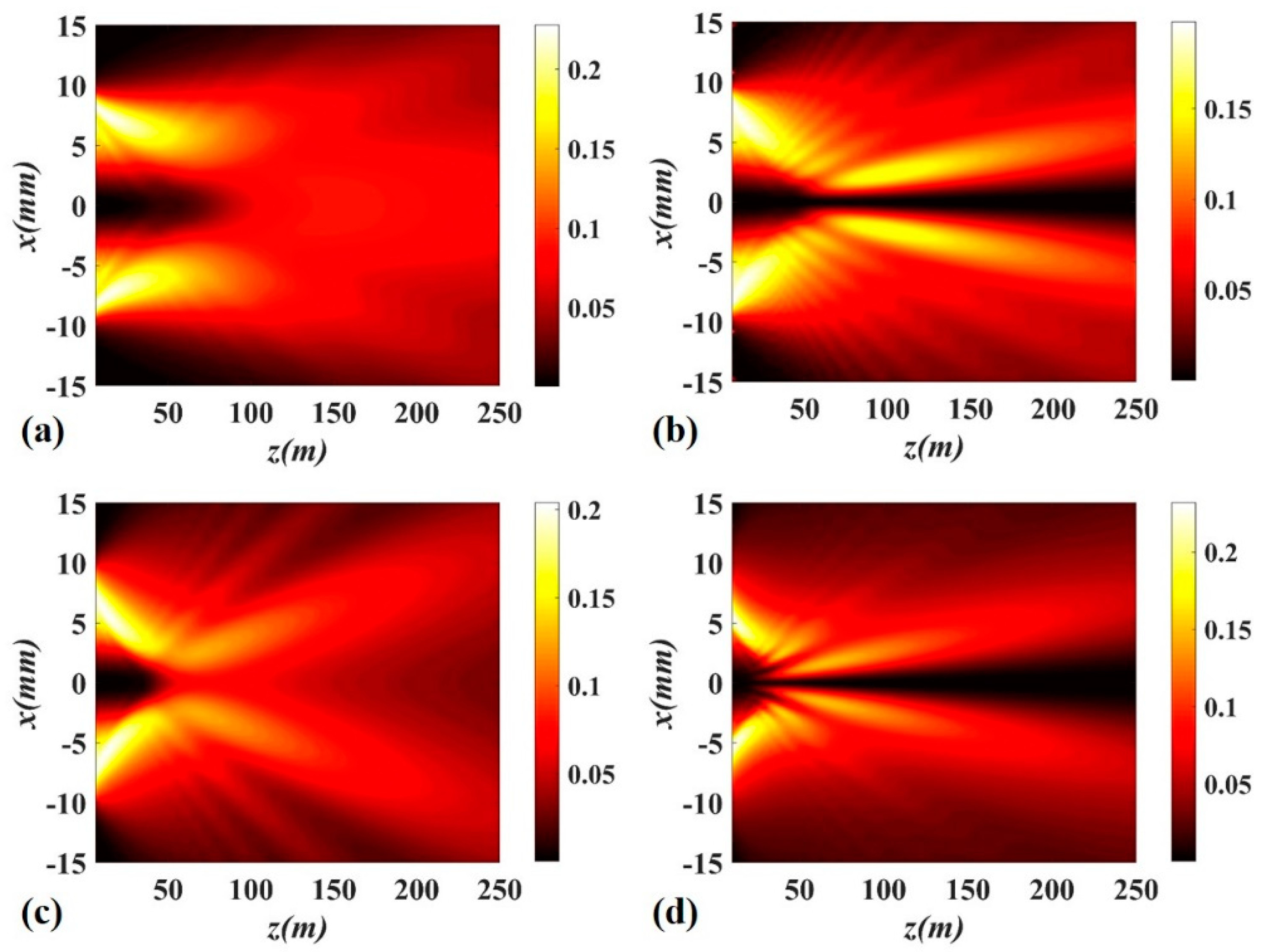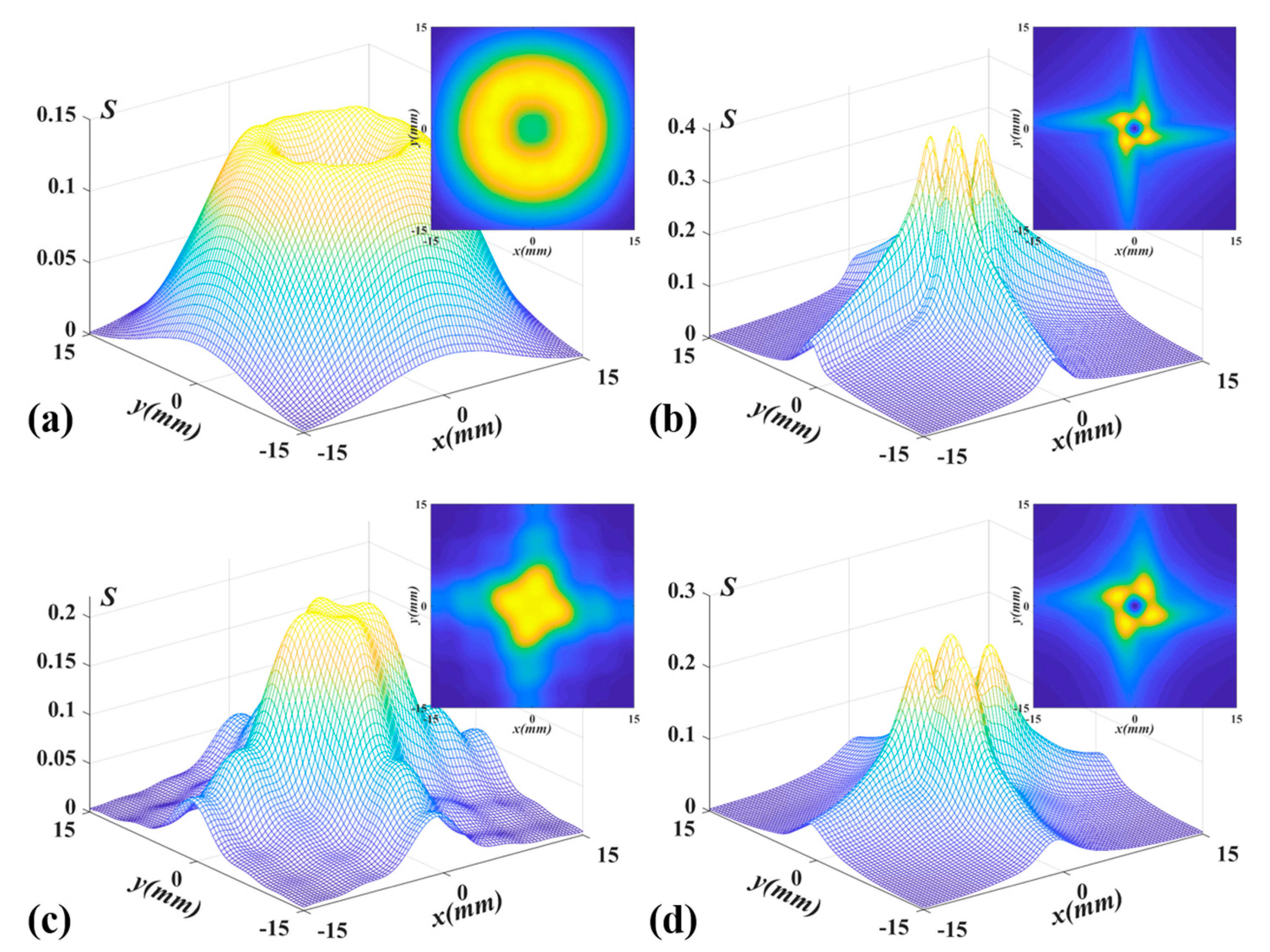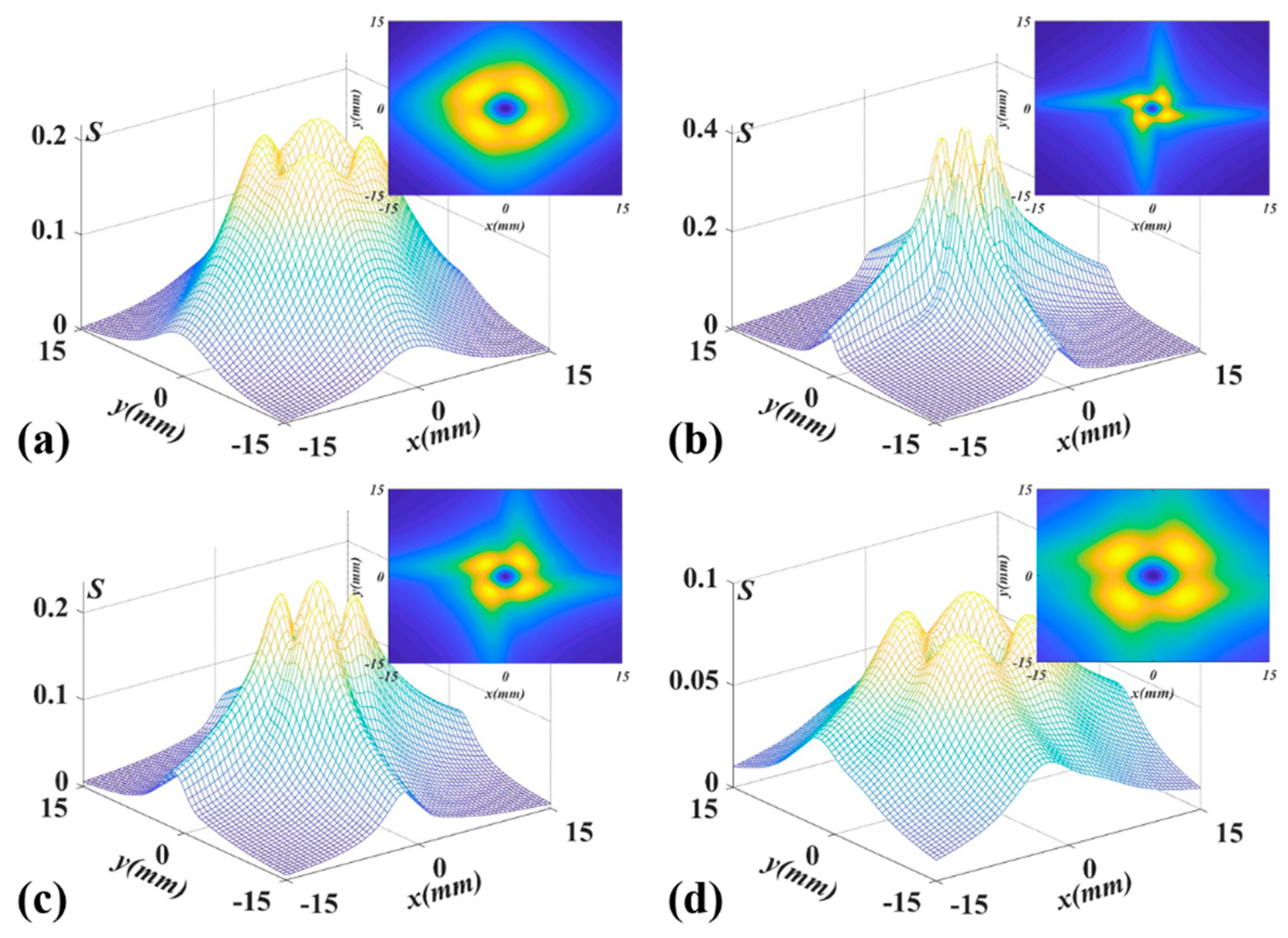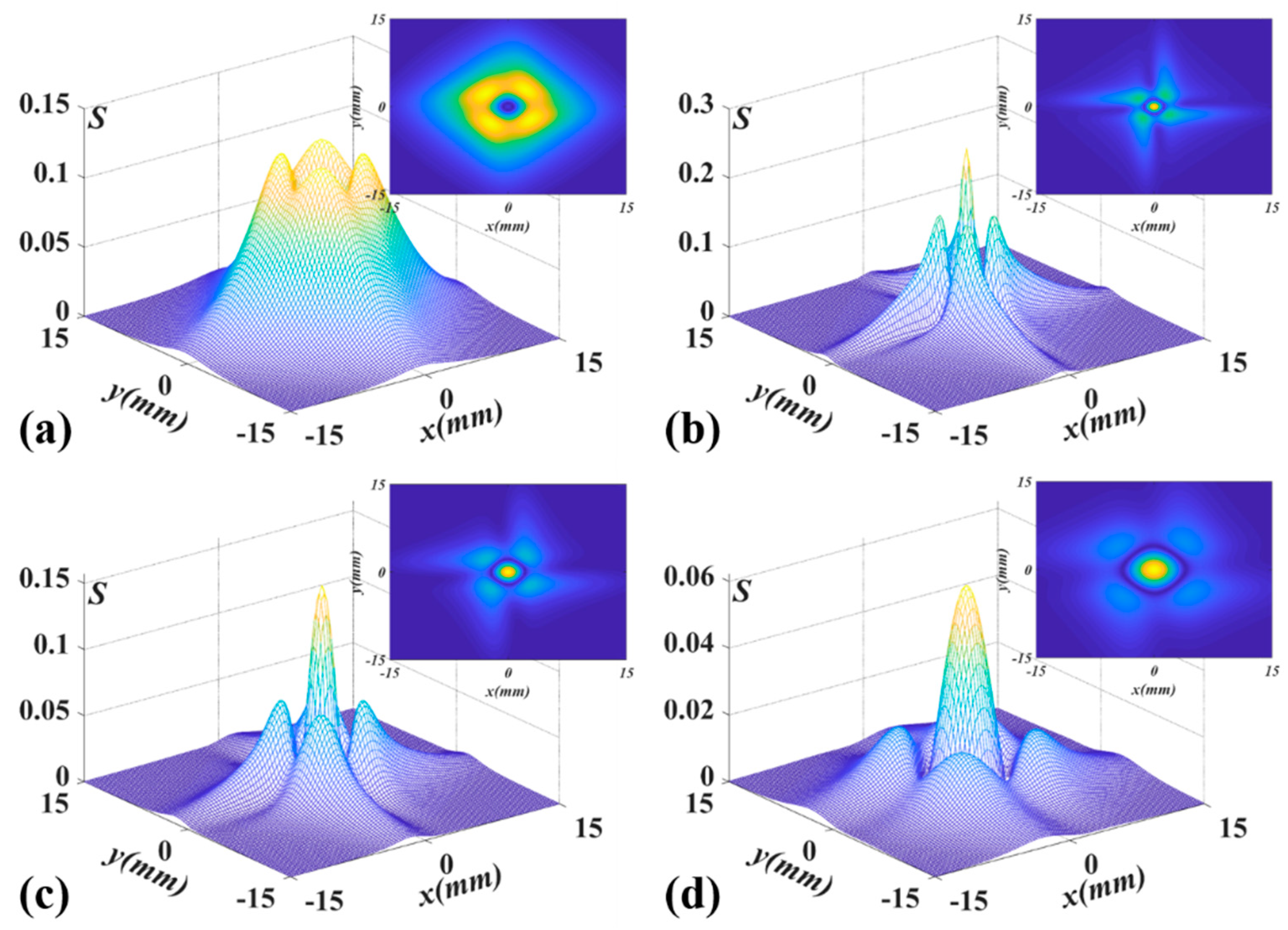High-Order Sinc-Correlated Model Vortex Beams
Abstract
1. Introduction
2. Sinc-Correlated Model Vortex Beams
3. Cross-Spectral Density of the SCMV Beams Propagating in Atmospheric Turbulence
4. Numerical Results
5. Conclusions
Author Contributions
Funding
Institutional Review Board Statement
Informed Consent Statement
Data Availability Statement
Conflicts of Interest
References
- Mandel, L.; Wolf, E. Optical Coherence and Quantum Optics; Cambridge University Press: Cambridge, UK, 1995. [Google Scholar]
- Starikov, A.; Wolf, E. Coherent-mode representation of Gaussian Schell-model sources and their radiation fields. J. Opt. Soc. Am. A 1982, 72, 923–928. [Google Scholar] [CrossRef]
- Gori, F.; Santarsiero, M. Devising genuine spatial correlation functions. Opt. Lett. 2007, 32, 3531–3533. [Google Scholar] [CrossRef] [PubMed]
- Gori, F.; Sanchez, V.; Santarsiero, M.; Shirai, T. On genuine cross-spectral density matrices. J. Opt. A Pure Appl. Opt. 2009, 11, 085706. [Google Scholar] [CrossRef]
- Cai, Y.; Chen, Y.; Wang, F. Generation and propagation of partially coherent beams with nonconventional correlation functions: A review. J. Opt. Soc. Am. A 2014, 31, 2083–2096. [Google Scholar] [CrossRef] [PubMed]
- Mei, Z.; Korotkova, O. Linear Combinations of the Complex Degrees of Coherence. Photonics 2021, 8, 146. [Google Scholar] [CrossRef]
- Lajunen, H.; Saastamoinen, T. Propagation characteristics of partially coherent beams with spatially varying correlations. Opt. Lett. 2011, 36, 4104–4106. [Google Scholar] [CrossRef]
- Tong, Z.; Korotkova, O. Nonuniformly correlated light beams in uniformly correlated media. Opt. Lett. 2012, 37, 3240–3242. [Google Scholar] [CrossRef] [PubMed]
- Korotkova, O.; Sahin, S.; Shchepakina, E. Multi Gaussian Schell-model beams. J. Opt. Soc. Am. A 2012, 29, 2159–2164. [Google Scholar] [CrossRef]
- Mei, Z.; Korotkova, O.; Shchepakina, E. Electromagnetic multi-Gaussian Schell-model beams. J. Opt. 2012, 15, 025705. [Google Scholar] [CrossRef]
- Korotkova, O.; Shchepakina, E. Rectangular multi-Gaussian Schell-model beams in atmospheric turbulence. J. Opt. 2014, 16, 045704. [Google Scholar] [CrossRef]
- Mei, Z.; Korotkova, O. Cosine-Gaussian Schell-model sources. Opt. Lett. 2013, 38, 2578–2580. [Google Scholar] [CrossRef] [PubMed]
- Mei, Z.; Korotkova, O. Random sources generating ring-shaped beams. Opt. Lett. 2013, 38, 91–93. [Google Scholar] [CrossRef]
- Strohbehn, J. Laser Beam Propagation in the Atmosphere; Springer: New York, NY, USA, 1978. [Google Scholar]
- Andrews, L.; Phillips, R. Laser Beam Propagation through Random Media; SPIE: Bellingham, WA, USA, 2005. [Google Scholar]
- Doronin, A.; Vera, N.; Staforelli, J.; Coelho, P.; Meglinski, I. Propagation of Cylindrical Vector Laser Beams in Turbid Tissue-Like Scattering Media. Photonics 2019, 6, 56. [Google Scholar] [CrossRef]
- Zhang, X.; Chen, Y.; Wang, F.; Cai, Y. Scattering of Partially Coherent Vector Beams by a Deterministic Medium Having Parity-Time Symmetry. Photonics 2022, 9, 140. [Google Scholar] [CrossRef]
- Zhou, G.; Chu, X. Propagation of a partially coherent cosine-Gaussian beam through an ABCD optical system in turbulent atmosphere. Opt. Express 2009, 17, 10529–10534. [Google Scholar] [CrossRef] [PubMed]
- Wang, Y.; Mei, Z.; Zhang, M.; Mao, Y. Propagation characteristics of a partially coherent self-shifting beam in random media. Appl. Opt. 2020, 59, 1834–1840. [Google Scholar] [CrossRef]
- Xiao, X.; Voelz, G.; Toselli, I.; Korotkova, O. Gaussian beam propagation in anisotropic turbulence along horizontal links: Theory, simulation, and laboratory implementation. Appl. Opt. 2016, 55, 4079–4084. [Google Scholar] [CrossRef]
- Cheng, M.; Guo, L.; Li, J.; Huang, Q.; Cheng, Q.; Zhang, D. Propagation of an optical vortex carried by a partially coherent Laguerre–Gaussian beam in turbulent ocean. Appl. Opt. 2016, 55, 4642–4648. [Google Scholar] [CrossRef]
- Xu, Y.; Xu, Y.; Wang, T. Evolution Properties of a Partially Coherent Twisted Laguerre-Gaussian Pulsed Beam Propagating through Anisotropic Atmospheric Turbulence. Photonics 2022, 9, 707. [Google Scholar] [CrossRef]
- Mei, Z.; Mao, Y.; Wang, J. Random sources with rectangular coherence. Opt. Express 2022, 30, 23284–23294. [Google Scholar] [CrossRef]
- Shchepakina, E.; Korotkova, O. Second-order statistics of stochastic electromagnetic beams propagating through non-Kolmogorov turbulence. Opt. Express 2010, 18, 10650–10658. [Google Scholar] [CrossRef] [PubMed]
- Toselli, I.; Andrews, L.; Phillips, R.; Ferrero, V. Free-space optical system performance for laser beam propagation through non-Kolmogorov turbulence. Opt. Eng. 2008, 47, 026003. [Google Scholar]
- Mei, Z.; Korotkova, O.; Zhao, D.; Mao, Y. Self-focusing vortex beams. Opt. Lett. 2021, 46, 2384–2387. [Google Scholar] [CrossRef] [PubMed]





Disclaimer/Publisher’s Note: The statements, opinions and data contained in all publications are solely those of the individual author(s) and contributor(s) and not of MDPI and/or the editor(s). MDPI and/or the editor(s) disclaim responsibility for any injury to people or property resulting from any ideas, methods, instructions or products referred to in the content. |
© 2023 by the authors. Licensee MDPI, Basel, Switzerland. This article is an open access article distributed under the terms and conditions of the Creative Commons Attribution (CC BY) license (https://creativecommons.org/licenses/by/4.0/).
Share and Cite
Wang, J.; Mei, Z.; Mao, Y.; Shi, X.; Zhou, G. High-Order Sinc-Correlated Model Vortex Beams. Photonics 2023, 10, 550. https://doi.org/10.3390/photonics10050550
Wang J, Mei Z, Mao Y, Shi X, Zhou G. High-Order Sinc-Correlated Model Vortex Beams. Photonics. 2023; 10(5):550. https://doi.org/10.3390/photonics10050550
Chicago/Turabian StyleWang, Jixian, Zhangrong Mei, Yonghua Mao, Xiaohui Shi, and Guoquan Zhou. 2023. "High-Order Sinc-Correlated Model Vortex Beams" Photonics 10, no. 5: 550. https://doi.org/10.3390/photonics10050550
APA StyleWang, J., Mei, Z., Mao, Y., Shi, X., & Zhou, G. (2023). High-Order Sinc-Correlated Model Vortex Beams. Photonics, 10(5), 550. https://doi.org/10.3390/photonics10050550




